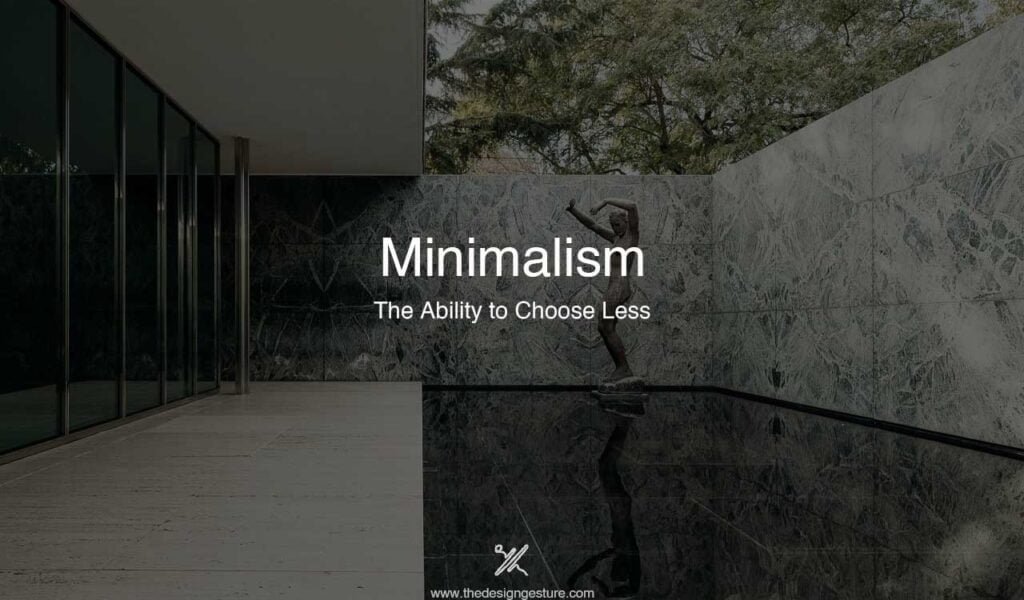Table of Contents
Introduction
Renowned architects like Walter Gropius, Philip Johnson, and Le Corbusier persistently pushed the boundaries of architecture in the 20th century. Architecture was being changed in a novel way by minimalism. But the best phrase was coined by German-American architect Ludwig Mies Van Der Rohe, “Less is More”. The minimalist movement in visual arts, music, and other media started in post-World War II Western art, although it was most prominent in American visual arts in the 1960s and early 1970s. The movement was frequently seen as a response to modernism and abstract expressionism; it predicted postmodern contemporary art activities that extend or reflect on minimalism’s initial goals.
Minimalist architecture, usually known as “minimalism,” makes use of basic design components without embellishment or decoration. Minimalists contend that reducing a design’s form and substance to their bare minimum shows the true “essence of architecture.” The 1920s Cubist-inspired Bauhaus and De Stijl movements gave rise to minimalist architecture. Architects like Ludwig Mies van der Rohe believed that minimalism gave architectural space the most strength.
Less is more is a philosophy that advocates putting only what is necessary in a space and clearing out clutter to make room for important objects and substance. To create beautiful structures out of only what is necessary is the aim of minimalist architecture. Clean lines and shapes, a restrained colour scheme, and simple materials all contribute to the calming atmosphere that minimalism generates.
Minimalism in Architecture and Design
A design and architectural movement known as minimalism refers to the reduction of a subject to its essential components. The link between two flawless surfaces, tasteful lighting, and the empty spaces produced by the removal of three-dimensional features are the main concerns of minimalist architects. According to a few observers, the rise of minimalism was a reaction to the impulsiveness and instability of metropolitan life. A remedy for the “overpowering presence of traffic, advertising, disorganised building scales, and towering roadways” was seen in the design.
The minimalist architectural style was used by architects to describe the aesthetics. A building’s necessary elements were arranged in a way to provide the sense of extreme simplicity by using every feature and detail to serve both aesthetic and functional reasons. The engineer’s philosophy of “Doing more with less” was adopted by designer Buckminster Fuller (1895-1983), however his concerns were more focused on technology and engineering than on aesthetics.
As of the current scenario, minimalism isn’t simply a design aesthetic; it’s also a way of life that focuses on the essentials.
Origin of Minimalism
Japanese traditional design and architecture have had a significant effect on minimalism. The works of De Stijl’s design movements are a prominent reference. De Stijl developed the notions of expression by methodically organising fundamental materials such as lines and planes. The origin of minimalist architecture can also be traced back to the Bauhaus architectural style of the 1920s. Despite the fact that each of these styles has a unique background and set of characteristics, they all serve the same function.
The German art school that gave life to the Bauhaus movement sought as its objectives the promotion of mass production and the fusion of technology and arts and crafts. De Stijl and the Bauhaus movement were closely related, strives to keep spaces, clutter-free and both emphasised simplified forms, functionalism, and cleanliness.
Famous architects like Ludwig Mies van der Rohe, who encapsulated its minimalist concept in the expression “Less is more,” helped this approach to architecture and design gain popularity after World War II and keep it going. The phrase “less is more” describes reducing shape to its most basic components. Even today, it is still used to describe minimalism.
When Japan’s cities saw tremendous urbanisation and population growth in the 1980s, minimalist architecture started to acquire popularity in the country. After moving to the United States in 1947, the Bauhaus gained notoriety as the International Style. In order to attain simplicity, architects and fashion designers collaborated in the boutiques of London and New York in the late 1980s, using white elements, cold lighting, and spacious spaces with a minimum amount of furnishings and items.
Concept and Key Characteristics
The idea of minimalist architecture is to simplify things by reducing them to their most basic components. The concept is to reduce as much clutter as possible, down to a bare minimum that all elements, features, and joinery to a point where nothing more can be removed to enhance the design—not that adornment is completely absent. It calls emphasis to a structure’s most basic shape while glorifying its fundamental structural components. Structures are nearly entirely devoid of decorative elements, making the structure itself the main attraction.
Minimalist designers take into account more than only the structure’s aesthetics. By listening to the figure and paying attention to certain qualities of form, light, space, and materials, they consider the spiritual dimension and the invisible, believing that this reveals the abstract quality of something that is invisible and facilitates the search for the essence of those invisible qualities—such as natural light, sky, earth, and air. Strategies like reduction, simplification, and unity, are also exemplified in minimalist architecture. These features are seen by minimalists as the “essence” of architecture.
This style’s colour schemes support the idea of utilising as little as possible. There is a lot of usage of neutral, calming colours like tan, white, grey, and black. Utilizing the fewest number of elements possible, the most visual impact is produced through carefully selected angles, materials, and lighting. Buildings’ natural light patterns show straightforward, uncluttered interiors.
Utilizing empty space is essential to achieve this. Simple building materials are employed, including steel, stone, concrete, and glass. These materials not only keep the building’s core as straightforward as possible, removing any needless adornment, but they also frequently feature neutral colours that go well with minimalist designs. People respected the attitude of “truth to materials” with attention to the profound and inherent properties of materials in the late 19th century, when the arts and crafts movement gained popularity in Britain. In search of essence and simplicity, minimalist architects respectfully “listen to figure,” recognising the desirable qualities in straightforward and everyday materials.
Minimalist Architects and Their Work
Famous Japanese minimalist architect, Kazuyo Sejima, collaborates with Ryue Nishizawa as SANAA to create distinctive Japanese Minimalist structures. Works include Small House (2000) Tokyo, New Museum (2010) New York City, and House Surrounded by Plum Trees (2003) Tokyo.
Tadao Ando, another Japanese minimalist architect, uses his creations to express his personal view of nature as well as the traditional Japanese spirit. His design principles are based on geometry, pure materials, and nature. In order to produce austerity and rays of light in space, he typically uses concrete or natural wood and a simple structural form. Japanese architecture has been greatly influenced by Ando’s creations and the translation of Japanese aesthetic concepts.
Le Corbusier is still a contentious subject. His suspected ties to fascism, antisemitism, and eugenics, as well as the dictator Benito Mussolini, have led to some ongoing disagreement. Some of his urban planning plans have been attacked for their disregard for pre-existing cultural places, societal expression, and equality. His most notable works were the Ronchamp Notre-Dame-du-Haut chapel and the Sainte Marie de La Tourette monastery. Chandigarh City was designed by Le Corbusier, and it was his biggest and most ambitious undertaking.
British minimalist architect John Pawson’s design principles are spirit, light, and order. His use of materials reveals how he perceives volume, surface, and space. He is drawn to the significant contributions of Japanese Zen philosophy.
One of the first people to properly design with the maxim “less is more” was Mies. In his architectural plans during World War I, Mies, as he was known, sought to achieve clarity and simplicity. In order to remove the decoration from architecture, he and others turned buildings, furniture, and teaching into their tools. The Chicago Federal Center complex, the Farnsworth House, Crown Hall, and other buildings at IIT, as well as the Seagram Building in New York, are just a few of his notable U.S. work. His later creations were modelled around these classic pieces. For wealthy clients, he also constructed residences.
The store Calvin Klein Madison Avenue in New York, which was open from 1995 to 1996, represents Calvin Klein’s sense of style. For this project, John Pawson’s interior design ideas aimed to produce straightforward, tranquil, and well-organized spatial configurations.
Impact of Minimalism in Architecture
In today’s architectural landscape, minimalist design is still in vogue. Architects from all over the world are inspired by its straightforward, zen-like atmosphere and pure lines. Minimalist design has had a significant impact on architectural styles since the 1920s. Whether buildings adopt a few key elements or are completely minimalist in style, minimalist architecture continues to have a significant influence on the field of popular architecture.
Conclusion
The powers of the minimalism in design are still being discovered. It may seem simple and uncomplicated to create, but after you’ve had a glass of minimalism, you understand the subtleties of building rooms with little possessions. This poses a significant problem to architects. Even while minimalism has many advantages, there are also some drawbacks likewise designers can’t cover flaws. The lack of decoration and the neutral colour scheme are perceived as uninteresting by many individuals.
Many of us would choose Mies van der Rohe’s short phrase, “less is more,” if we had to quickly define what minimalism meant. At the moment, minimalism is ingrained in our lives as well as in the architecture. Maybe this is why minimalism has come to represent something.




